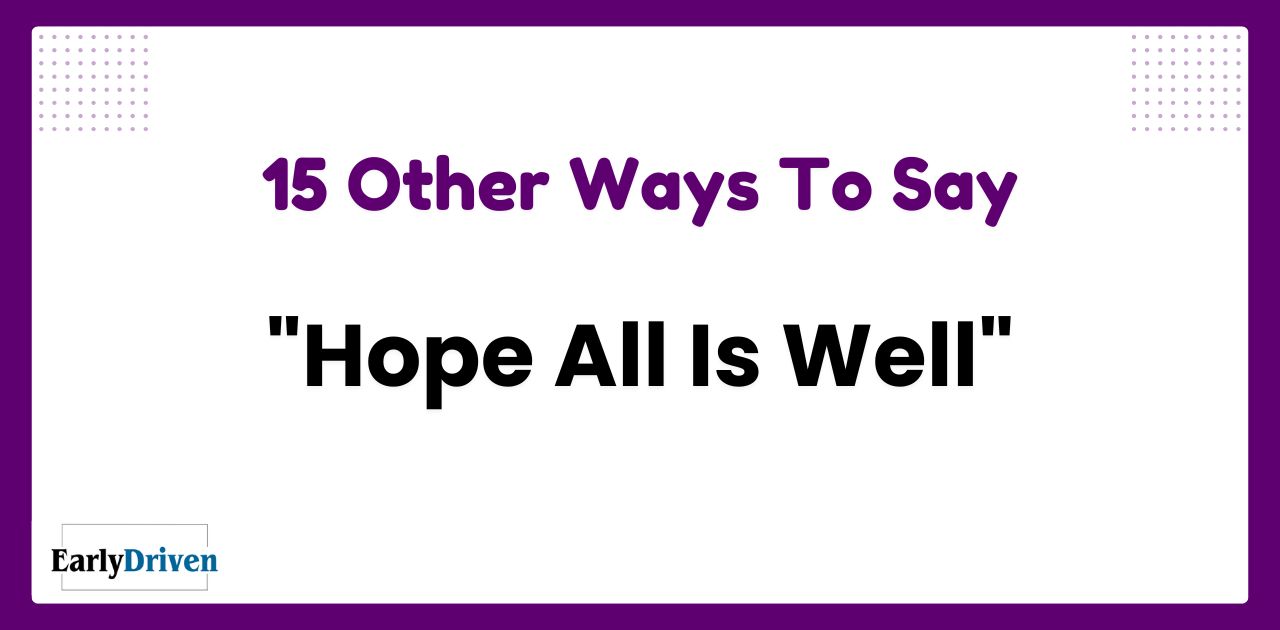In today’s fast-paced professional environment, starting emails effectively sets the tone for meaningful communication. While “Hope all is well” has become a standard greeting, its overuse can make your messages feel impersonal. This article explores fifteen thoughtful alternatives that maintain professionalism while adding a personal touch to your business correspondence.
Understanding the Purpose of “Hope All Is Well”
The phrase “Hope all is well” serves as a professional courtesy that bridges the gap between formal and friendly communication. However, using more personalized alternatives can strengthen professional relationships and demonstrate genuine interest in your colleagues’ well-being.
Other Ways to Say “Hope All Is Well”
- I Hope You’re Doing Well
- Trust All is Well with You
- Wishing You Well
- I Hope Everything is Going Well
- I Hope All is Well on Your End
- Hope You’re Having a Great Day/Week
- I Trust Everything is Going Smoothly
- I Hope Things are Looking Up
- Everything Going Alright with You?
- Thinking of You Today
- I Hope Life is Treating You Well
- Just Checking In
- How Have You Been?
- Sending Positive Vibes
- Hope All Is Good
1. I Hope You’re Doing Well
In professional communication, “I hope you’re doing well” serves as a refined opening that bridges formality with genuine concern. This phrase has become increasingly valuable in business correspondence as organizations emphasize emotional intelligence and personal connection in workplace relationships.
When using this greeting, the tone conveys respect while acknowledging the recipient’s overall well-being. For instance, in a business email to a colleague returning from leave, you might write:
Example: “I hope you’re doing well after your return to the office. Your expertise was greatly missed during the strategic planning sessions, and I’m looking forward to catching up on several initiatives that could benefit from your insight.”
This approach demonstrates professional courtesy while creating space for meaningful dialogue about work-related matters.
2. Trust All is Well with You
The phrase “Trust all is well with you” carries a formal dignity particularly suited for senior-level communication. It implies respect for the recipient’s position while maintaining appropriate professional distance. This greeting works especially well in situations requiring diplomatic finesse or when addressing multiple stakeholders.
Consider this example in a cross-departmental email:
Example: “Trust all is well with you and your team as we approach the fiscal year-end. The finance department’s guidance has been instrumental in helping us align our objectives with the company’s strategic goals.”
3. Wishing You Well
“Wishing you well” offers versatility in professional settings while conveying genuine good wishes. This phrase particularly shines when acknowledging professional milestones or supporting colleagues through challenges.
For example, in a message to a team member preparing for a significant presentation:
Example: “Wishing you well as you prepare for tomorrow’s board presentation. Your thorough preparation and expertise in market analysis will undoubtedly serve you well in showcasing our department’s achievements.”
4. I Hope Everything is Going Well
This phrase carries a comprehensive concern for both professional and personal well-being, making it particularly effective in maintaining long-term business relationships. When used thoughtfully, it opens the door for meaningful updates while respecting professional boundaries.
In a client relationship context, you might write:
Example: “I hope everything is going well with your business expansion into the Asian markets. Our team has been following your company’s progress and would value the opportunity to discuss how our services could support your growth initiatives.”
5. I Hope All is Well on Your End
This greeting acknowledges the geographical and operational distinctions in modern business environments, particularly relevant in remote or hybrid work settings. It shows awareness of different business contexts while maintaining professional connection.
For example, in cross-regional communication:
Example: “I hope all is well on your end as you navigate the seasonal market fluctuations in the European sector. We’ve observed similar patterns here in North America and would appreciate your insights on regional adaptations.”
6. Hope You’re Having a Great Day/Week
While maintaining professionalism, this greeting injects positivity into business communication. It’s particularly effective for regular interactions with colleagues and clients where a balance of friendliness and professionalism is established.
Consider this example in a project update email:
Example: “Hope you’re having a great week as we approach the final phase of the product launch. The marketing metrics from our soft launch indicate strong market reception, and I’m eager to share the detailed analytics with you.”
7. I Trust Everything is Going Smoothly
This phrase conveys confidence and professional optimism while opening the door for honest dialogue about project status or business developments. It’s particularly effective in management communication.
In a supervisor’s email to their team:
Example: “I trust everything is going smoothly with the system migration. Your dedication to maintaining operational excellence during this transition has been remarkable. Please don’t hesitate to highlight any areas requiring additional support.”
8. I Hope Things are Looking Up
This greeting shows emotional intelligence and professional empathy, particularly valuable when following up after challenging business situations or organizational changes.
For instance, in a follow-up email after a difficult quarter:
Example: “I hope things are looking up since our last discussion about market challenges. Our analysis suggests several promising opportunities for recovery, and I’d appreciate your perspective on the proposed strategies.”
9. Everything Going Alright with You?
This direct yet caring approach works well in established professional relationships where a degree of familiarity exists. It encourages open communication while maintaining professional boundaries.
Example in a team leader’s message:
Example: “Everything going alright with you? I noticed some innovative approaches in your recent project proposals and would value your thoughts on implementing these ideas across other departments.”
10. Thinking of You Today
This professionally empathetic greeting demonstrates thoughtful leadership and relationship management in business settings. When used appropriately, it strengthens professional bonds while maintaining appropriate workplace boundaries.
For example, in a message to a colleague preparing for an important client presentation:
Example: “Thinking of you today as you lead the annual stakeholder meeting. Your preparation and expertise in financial modeling have positioned you well for this important discussion. The executive team has noted your thorough approach to the quarterly projections.”
This greeting becomes particularly effective when tied to specific professional contexts or achievements, showing both awareness and support of colleagues’ professional journeys.
11. I Hope Life is Treating You Well
This greeting balances professional courtesy with genuine human connection, particularly valuable in long-term business relationships. It acknowledges the whole person while maintaining professional parameters.
Consider this example in a business development context:
Example: “I hope life is treating you well as you settle into your new role as Regional Director. Your strategic vision has already made a notable impact on our Asia-Pacific operations, and I look forward to our continued collaboration on expanding market presence.”
12. Just Checking In
This direct yet considerate approach serves well in professional follow-ups and project management contexts. It demonstrates proactive communication while respecting time constraints.
In a project management scenario:
Example: “Just checking in on the status of the sustainability initiative. Your team’s innovative approaches to reducing our carbon footprint have garnered attention from industry leaders, and I’d appreciate an update on implementation timelines and any resources needed for the next phase.”
13. How Have You Been?
Beyond its casual appearance, this greeting carries professional weight when used thoughtfully in business settings. It invites meaningful dialogue while maintaining professional boundaries.
In a business mentor relationship:
Example: “How have you been since taking on the leadership of the innovation team? Your implementation of agile methodologies has shown promising results, and I’d value hearing your insights on the transformation process and any challenges you’ve encountered.”
14. Sending Positive Vibes
While maintaining professionalism, this modern greeting can energize business communication, particularly in creative industries or startup environments. It should be used selectively based on organizational culture.
Example in a creative team communication:
Example: “Sending positive vibes as you finalize the brand refresh campaign. Your creative direction has successfully balanced our established market presence with fresh, forward-thinking elements. I look forward to reviewing the final presentation materials.”
15. Hope All Is Good
This concise yet effective greeting works well in regular professional correspondence where ongoing relationships are established. It opens communication channels while respecting time constraints.
In a weekly team update:
Example: “Hope all is good as we enter the final quarter. The data analytics from our recent market research suggest several opportunities for optimization, and I’d appreciate your strategic input on prioritizing these initiatives.”
Best Practices for Professional Email Openings
- Consider your relationship with the recipient
- Match your tone to the organizational culture
- Be mindful of timing and context
- Keep greetings concise but meaningful
- Maintain consistency in follow-up communications
Examples of Scenarios Where Email Openings Matter
- First-time business introductions
- Follow-up after important meetings
- Regular team communications
- Client relationship management
- Cross-departmental collaboration
FAQ’s
Q: When is “Hope all is well” too casual?
A: In formal business situations or first-time communications with senior executives.
Q: How can I make my email openings more personal?
A: Reference specific projects or recent interactions while maintaining professionalism.
Q: Should email openings change based on company culture?
A: Yes, adapt your tone to match organizational communication styles while maintaining professionalism.
Conclusion
Effective professional communication begins with thoughtful greetings that build rapport while maintaining business etiquette. These alternatives to “Hope all is well” help create meaningful connections in your professional correspondence. Choose the most appropriate option based on your relationship with the recipient and the context of your communication.
Remember that successful business communication balances professionalism with personality, creating an environment where meaningful dialogue can flourish. By incorporating these alternatives thoughtfully, you’ll enhance your professional relationships and communication effectiveness.
Elevate you English Learning skills with us!

“Smith, At EarlyDriven, our dedicated team of experienced writers and journalists brings you comprehensive coverage across entertainment, celebrity news, and educational content. With expertise in digital media and a commitment to accuracy, we craft engaging stories that inform, educate, and entertain our global readership.










